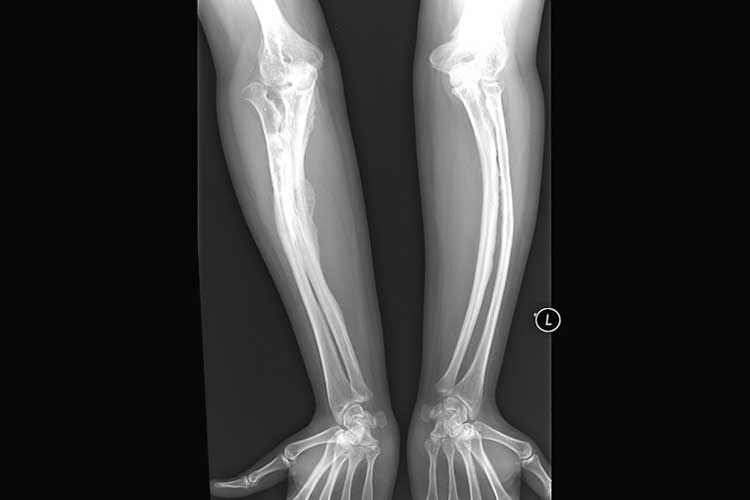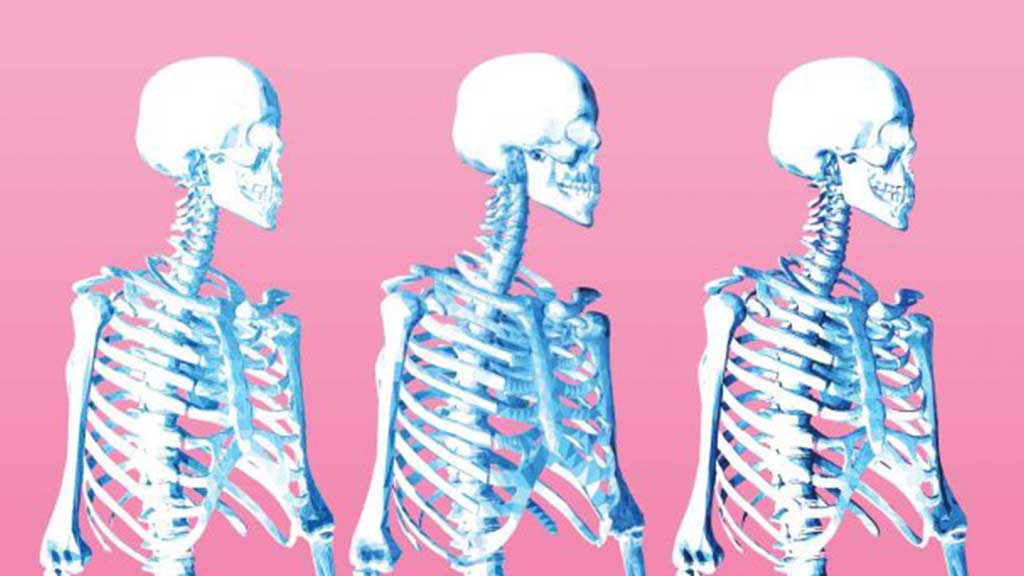Osteogenesis imperfecta (OI), which translates to ‘bones formed imperfectly’, is a rare genetic condition that causes bones to be fragile (MedlinePlus 2020).
It’s estimated to affect about 1 in 20,000 people (Raising Children Network 2021).
Due to its rarity, healthcare professionals may have limited awareness, understanding and experience when caring for individuals with this condition.
Types of Osteogenesis Imperfecta
There are five main types of OI, ranging from mild to severe, with the mildest form of OI also being the most common. There are also many subgroups of these types (Raising Children Network 2021).
Type 1 OI is the mildest form of OI, and may not be diagnosed until later in life, whereas the more severe types of OI can cause infant death during or shortly after birth, often as a result of respiratory failure (The OI Society of Australia 2016).
The five main types of OI can be classified as follows:
| Type I: non-deforming OI with blue sclerae | This is the mildest form of OI and is characterised by increased bone fragility, blue sclerae and increased susceptibility to hearing loss. |
| Type II: Perinatally lethal OI syndromes | This is the most severe and deadly type of OI. It is often detected at 18 to 20 weeks gestation, and sadly, babies with this type of OI will rarely survive. |
| Type III: Progressively deforming OI | OI will be present in these individuals from birth with bone fragility and multiple fractures leading to a progressive deformity of their skeleton. In the past, many individuals with this type of OI didn't survive into adulthood due to complications of skeletal chest wall deformity causing pulmonary hypertension, cardio-respiratory failure and kyphoscoliosis. However, with current therapeutic options, these individuals are now surviving into adulthood. |
| Type IV: Common variable OI with normal sclerae | These patients have recurrent fractures, osteoporosis and deformity of both the long bones and spine, but will have normal sclerae by the time they reach late childhood. |
| Type V: OI with calcification in interosseous membranes | This type of OI is indicated by moderate to severe bone fragility with progressive calcification of the inter-osseous membranes in the forearm and legs. |
(Raising Children Network 2021; Van Dijk & Sillence 2014)

Causes of Osteogenesis Imperfecta
OI is caused by a mutation in one of the two genes that produce collagen. It causes the person to have either a decreased amount of collagen or poorer quality collagen, which then causes their bones to be weak and consequently fracture more easily (Raising Children Network 2021).
The mutated gene can be inherited from one or both parents or can be the result of a new and random mutation. It's important to note that parents of a child with OI often will not display OI themselves (The OI Society of Australia 2016; Van Dijk & Sillence 2014).
Diagnosing Osteogenesis Imperfecta
Diagnosis occurs as a result of investigations being undertaken due to a child experiencing frequent fractures. As well as frequent fractures, OI may be diagnosed through clinical signs and tests such as:
- Blue sclerae: Note that this is not present in all types of OI
- Opalescent teeth: Not present in all types of OI
- Family history: However, in many cases of OI, there will be no family history of OI
- Blood tests: These include calcium, phosphorus and serum alkaline phosphate. Blood tests are important in order to exclude other causes
- Urine tests: These allow determination of the level of bone breakdown and turnover occurring
- X-rays: Many OI patients will have Wormian bones, which are extra bones present in the skull
- Bone density scans
- Genetic testing.
(The OI Society of Australia 2016; Raising Children Network 2021)
How Does Osteogenesis Imperfecta Present?
People with OI will often be of short stature, have blue-tinted sclerae, some form of hearing loss, brittle teeth, muscle weakness, hypermobility and potentially, progressive skeletal deformity and restricted breathing (The OI Society of Australia 2016; Raising Children Network 2021).
Many people will also be diagnosed with osteoporosis. There may also be cardiovascular effects related to OI, which are usually reported in adults rather than children. These could include forms of valve dysfunction and aortic root dilation (Subramanian et al. 2023).
Another implication for adults with OI is that 50% of patients will have a hearing impairment by the age of 40. Vertigo may also occur (Ramachandran 2022).
Care for individuals with OI should take into account not only connective tissue and bone deformities but also the consequential effects of the condition.
Pain is also often present in individuals with OI and, when uncontrolled, can negatively impact the individual’s quality of life (Cortés et al. 2022).
It's important to note that the symptoms of OI may differ between types. There are many common variables between the types, although some symptoms are more common in certain types of OI than others.
Therefore, if you are caring for someone with OI, it's important to determine which type of OI they have and what symptoms they are experiencing.
Treating Osteogenesis Imperfecta
As a genetic condition, OI will often affect many of the body systems and cannot be cured. Therefore, treatment aims to manage some of the associated signs and symptoms (Ramachandran 2022).
One of these treatments includes intravenous bisphosphonate therapy to help treat bone fragility, increase bone density and decrease fracture rates (Ramachandran 2022).
The implementation of management strategies for individuals with OI is also an important part of treatment. Therefore, the healthcare professional’s role needs to focus not only on assisting with treatment strategies but also on management strategies in areas such as pain, mobility, hearing impairment and any modifications to maintain the individual's quality of life.
Test Your Knowledge
Question 1 of 3
Which one of the following is the mildest form of osteogenesis imperfecta?
Topics
References
- Cortés, RM, Pastor, JFS & Dolz, VM 2022, ‘Chronic Pain in Adults with Osteogenesis Imperfecta and its Relationship to Appraisal, Coping, and Quality of Life: A Cross-Sectional Study’, Medicine (Baltimore), vol. 101, no. 40, viewed 16 January 2024, https://www.ncbi.nlm.nih.gov/pmc/articles/PMC9542837/
- MedlinePlus 2020, Osteogenesis Imperfecta, U.S. Department of Health and Human Services, viewed 15 January 2024, https://medlineplus.gov/genetics/condition/osteogenesis-imperfecta/
- The OI Society of Australia 2016, What is OI, The OI Society of Australia, viewed 15 January 2024, https://www.oiaustralia.org.au/about-oi/
- Raising Children Network 2021, Osteogenesis Imperfecta, Raising Children Network, viewed 15 January 2024, https://raisingchildren.net.au/disability/guide-to-disabilities/assessment-diagnosis/osteogenesis-imperfecta
- Ramachandran, M 2022, Osteogenesis Imperfecta (OI), Medscape, viewed 16 January 2024, viewed 16 January 2024, https://emedicine.medscape.com/article/1256726-overview
- Subramanian, S, Anastasopoulou, C & Viswanathan, VK 2023, ‘Osteogenesis Imperfecta’, StatPearls, viewed 15 January 2024, https://www.ncbi.nlm.nih.gov/books/NBK536957/
- Van Dijk, FS & Sillence, DO 2014, ‘Osteogenesis Imperfecta: Clinical Diagnosis, Nomenclature and Severity Assessment’, American Journal of Medical Genetics, vol. 164, no. 6, viewed 15 January 2024, https://onlinelibrary.wiley.com/doi/full/10.1002/ajmg.a.36545

